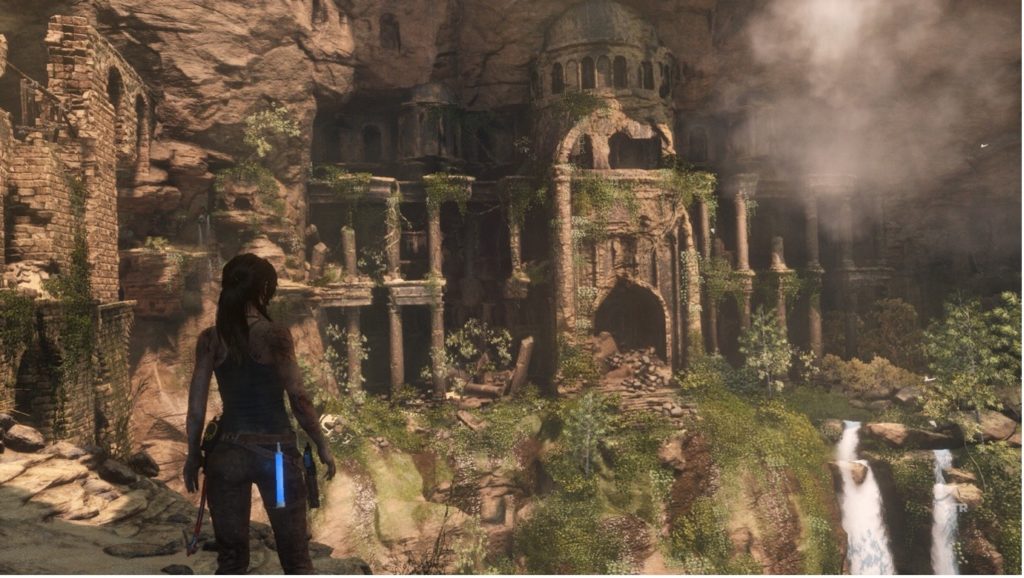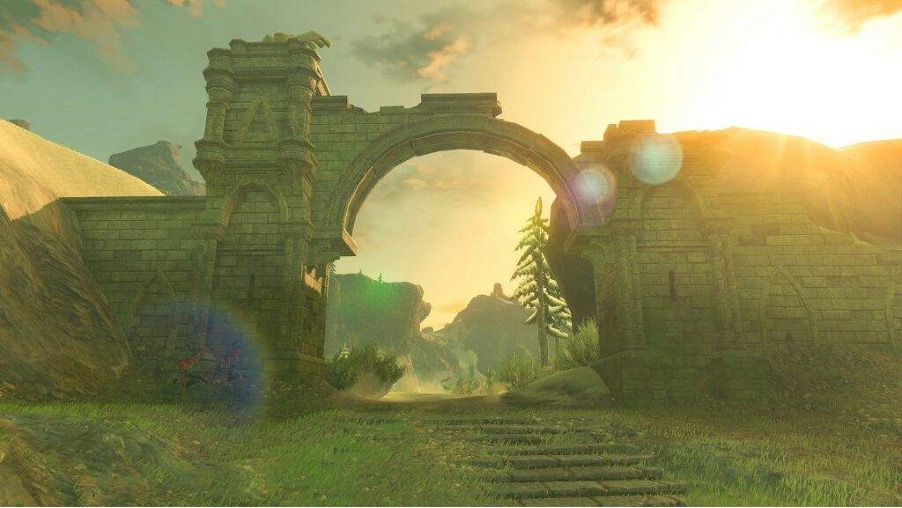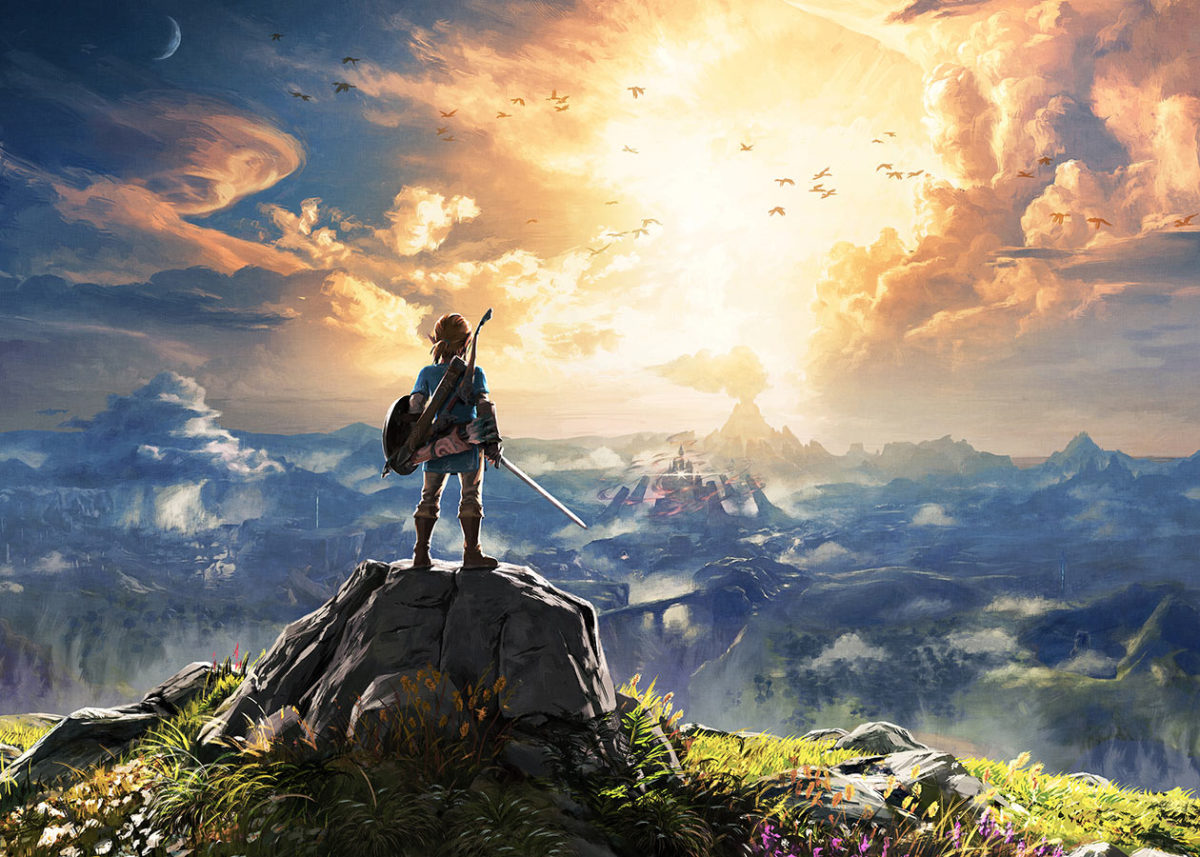When I think about the first ‘historical’ game that I ever played, I come up short. I didn’t play series like Age of Empires or Sid Meier’s Civilization until I was older – not because of my age, but because I didn’t have ready access to a gaming PC setup until I was in my twenties. As a result, the games that come to mind are console and Mac games that deal with ostensibly historical environments – Tomb Raider, Prince of Persia, even the 1987 fantastical action RPG platformer Wonder Boy. As a child and young adult, these environments evoked rich visions of landscapes that could have been drawn from National Geographic, or 1950’s educational book-sets with titles like “Children’s Library of World History”, or “A Treasury of Myth and Folk Lore”. The pixelated form of Tom-Tom from the Wonder Boy series, for example, suggests a cave-dwelling past, but also a mythological narrative, with enemies that resemble Cyclops or Medusa.
Wonder Boy (1987) (via Internet Archive)
Of course, these are not the kinds of games we would ordinarily consider ‘historical’ – they don’t deal in any way with narratives of formal history (as in the progress-oriented objectives of the Civilization series), nor are they set in historical eras or contexts (as in Assassin’s Creed‘s 15th Century Venice, for example). Nevertheless, I would argue that there is something of the past in the designs, settings and architectures of many games that we would never otherwise interpret as historical or heritage-related works.
Take Tomb Raider as another example – the character Lara Croft and her travels are fictional (and frequently laughable in their disconnect from reality), and most of the settings are the same gestural throwaways that we see in James Bond or (unsurprisingly) Indiana Jones movies. Yet the temples, ziggurats, and underground tombs are very much those of historic record – displaying the tendencies of colonialism, both the exoticising narratives, and extraction logics. The environment is then a citation of historical frames – in the case of Tomb Raider, Howard Carter’s Egyptian archaeology expeditions, translated several times through literature and film, amalgamated into a genre-setting gaming series that replicates the vine-covered, ruinous image of a ‘tomb’ raider’s surroundings: the crumbling relics of former civilisations (though in later games Lara also simply steals from living cultures, as well – not unlike Carter, to be honest).
It’s a trope that we should all know well – the intrepid explorer who journeys to far away foreign lands, somehow survives a series of dangerous mishaps, and returns triumphantly with a treasure hoard from an inaccessible and abandoned location (a place that should probably be a world heritage site, and where treasure hunters likely have no business being in the first place). Here, the environment connects the action – typically shooting, climbing and navigating obstacles, rappelling, and swimming – to a recognisable narrative that helps to stitch together the total experience of the game. Why should players care about gathering all these lost idols and jade figures without the suggestive ruin, and the loot-seeking adventurer?

What I am proposing is that although some games aren’t historical in the sense of their content, they can be read as historically loaded texts because of the role that their environments play in situating them within contemporary historical imaginations, helping the game make sense within wider cultural tropes. (I have made this argument elsewhere, in some detail, in relation to the image and space of ruin in games).
What do we mean by environment, anyway?
From here, I would suggest two initial ways to think of ‘environment’ in games: as a representation of the space, place, world, and landscape of the game; and as a technical term for the design and interaction with this represented space. In the case of the former, we might begin by talking about the imagination of the past that pre-dates digital gaming, and which is immediately bound up in discourses about ‘savagery’ and ‘civilisation’, history, progress and human nature: the idea of a natural pre-modern world, where people and animals run ‘wild’ (the kind of primordial forests that feature in many RPG and adventure games, or in the landscape of early Wonder Boy games); the colonial narrative of a landscape to be tamed, brought to heel by human development and progress, a line that runs from pre-human to civilisation, and on to the stars (consider the evolution-focused Spore as a case in point, or Outer Wilds’ depiction of interstellar colonisation).
The latter type, environment as designed space, would include object and landscape modelling; cover and concept art; 2D and 3D art design – design practices that aren’t exclusive to games, and which extend to architecture and urban planning (consider Arup’s 3D model of Admiralty Station in Hong Kong). Specific to games is the way in which a player may navigate a particular level or area through topographies and pathways that unveil the gameworld and/or the story. The action relies heavily – and sometimes totally – upon the environment design, often through the insertion of hinderances that you might find in a physical landscape. Players are guided by boulders, steep cliffs or sheer drops, high fences, deep water – but also architecture: collapsed walls; basements and bunkers; city elements like roads, fences, and train stations. I’m thinking especially here of the Fallout series and The Last of Us (both focused on an imagined future history in cities that we might recognise from our present – or, to put it another way, in which our present becomes the games’ past), but there are many others.

In historical games, specifically, the environment often serves to orient the player in a particular period or moment. A significant contributor here would be turn-based and strategy games set in ‘Ancient’ Rome, Egypt, or historically significant European battlefields – where a player manoeuvres troops, stages war, and takes vast territories in order to win the game. The environment – in both senses – is made up of a top-down, God’s-eye view (as if a drone were flying over Pharaoh’s pyramids, or a crusader king’s armies), where the map and the site of action are basically one and the same. In this case, ‘environment’ doesn’t have to mean a 3D, navigable landscape that replicates our own physical movement through the world, down to vistas and architectural facades. This kind of environment is an interactive and animated tabletop war game, simulating both war, but also the experience of wargaming, of being the omnipotent commander or even God-figure looking over the field. The environment designers have created a gameworld, an imagined space – not just the landscape from above, but also images of buildings cities to be conquered that pop up periodically, cover art, even sounds (the clash of a battle; running water or drenching rain). These elements together paint a portrait of a more-fully-fledged environment, without demanding 3D space that is navigated via a single avatar.
Citations of history – reality and ruins
Moving on from these two distinctions, environment in games can also extend to the more general sense of environment as a new situation for the player to explore. The wider context of game environments includes the narrative elements of setting and gameworld – where is this place in which the player finds themselves? What elements can assist the player in grounding and orienting their play experience? How can the landscape help to create an immersive environment that is at once believable, and exciting, interesting? This might include the same sounds of nature or action that develop out of spatial and environment design.
Could we thus begin to consider fantasy games like Legend of Zelda: Breath of the Wild to be historical in some ways – through the affective codes and actions built into the environment? Elements like weather, interactive texture (slippery rocks), and architectural decay all build a sense of environment as both game-world mired in its own history, but also in a Japanese interpretation of a Western history – specifically, European ruins – a unique situation cobbled together from many other environments. As an example, the ancient ruins of the Great Plateau remind me distinctly of historic sites like Bolton Abbey or Fountains Abbey in the North of England – so much so that I can’t help thinking this must have been the source material – even if by indirect association (just as these ruins were often inspiration for Romantic paintings, or Eighteenth Century follies in landscaped gardens).

Within all of this context is a fourth, more general, notion of the environment as that space in which a being – a human, a dog, an elephant – might become habituated and thrive. To consider again the historical context: the term environment was once simply your immediate surroundings – that which was around you (or around anything, really). It has since come to take on an ecological meaning with environmentalism – following texts like Rachel Carson’s Silent Spring, ‘The’ environment came to mean so much more: the resources and lands that sustain you; the air that you breathe; the rain and sun that weather the landscape. For a long time, games came up short in their ability to represent the layered tapestry of the physical environment – there were flat graphics and moving sprites; blue skies or little slashes for rain; forests and deserts; brown roads with green blobs for bushes – and not much else. Without shadow and texture, variable weather or lighting, games presented environments that were flat and static. Even now, unlike the ever-shifting landscapes of the ‘natural’ world, gaming environments remain mere typologies of weather and ecosystems, but they do increasingly engage with environmental politics and concerns. That isn’t to say that we ought to measure games by their verisimilitude – their ability to exactly model or replicate ‘real’ life – but that the capacity for games to represent our lived environments (let alone the monolithic ‘environment’ of contemporary concerns) was historically limited by the problem of the sheer complexity of the environment (as a place, as a concept), and lack of complexity of gaming hardware, software, and systems.
In many ways, this is no longer the case. Games can accurately model (at least sections of) the cities of the world – the environments in which the majority of us spend the majority of our time. They can present varied weather systems that are difficult to predict or plan for. The landscapes themselves can even transform over time – with the seasons, for example. Heritage games can present three-dimensional recreations of a lost past (often with debateable accuracy), while VR and AR provide the potential to fuse screen-based representations and physical or haptic feedback between player and landscape. Much of this capacity is due to the multiple meanings and affordances of environments: the capacity to produce space and place, often using historical frames as short-cuts to an immersive setting for the story and action; the capacity to design – visually, spatially – interactive worlds that can be navigated or interpreted as landscapes and topographies, in which the environment is like a world that we know – whether bodily, or from existing historically-derived frames. More generally, the relationship between our knowledge of history-as-historical-environment (epitomised by ruins and remnants), and the capital T ‘the environment’ (a signifying concept that pops up in beautiful and fantastical games) helps to problematise strict definitions of what historical games – and gaming environments – might mean.
So, am I suggesting here that we can liken real-world and game-world environments? And if so, what about this distinction between the representation of ‘the environment’, or landscape, and the idea of ‘environment’ within world-building, scene setting, level and mission design, and so on? Does this expanded definition help to re-evaluate both the role of environment and environmental design in games, or is it simply complicating an already-confusing melee of terminology and frames of analysis? We’d love to hear your perspectives and responses!
Dr Emma Fraser is an Assistant Teaching Professor in Media Studies and the Berkeley Center for New Media at UC Berkeley. Emma’s research considers games and play across sociology, geography, game studies and media and cultural theory. Emma also researches and writes about space and place, modern ruins, and visual media in relation to urban experience and the writings of Walter Benjamin and the Frankfurt School. Emma teaches digital media methods, digital storytelling, game studies, and new media theory and practice to graduate and undergraduate students.
